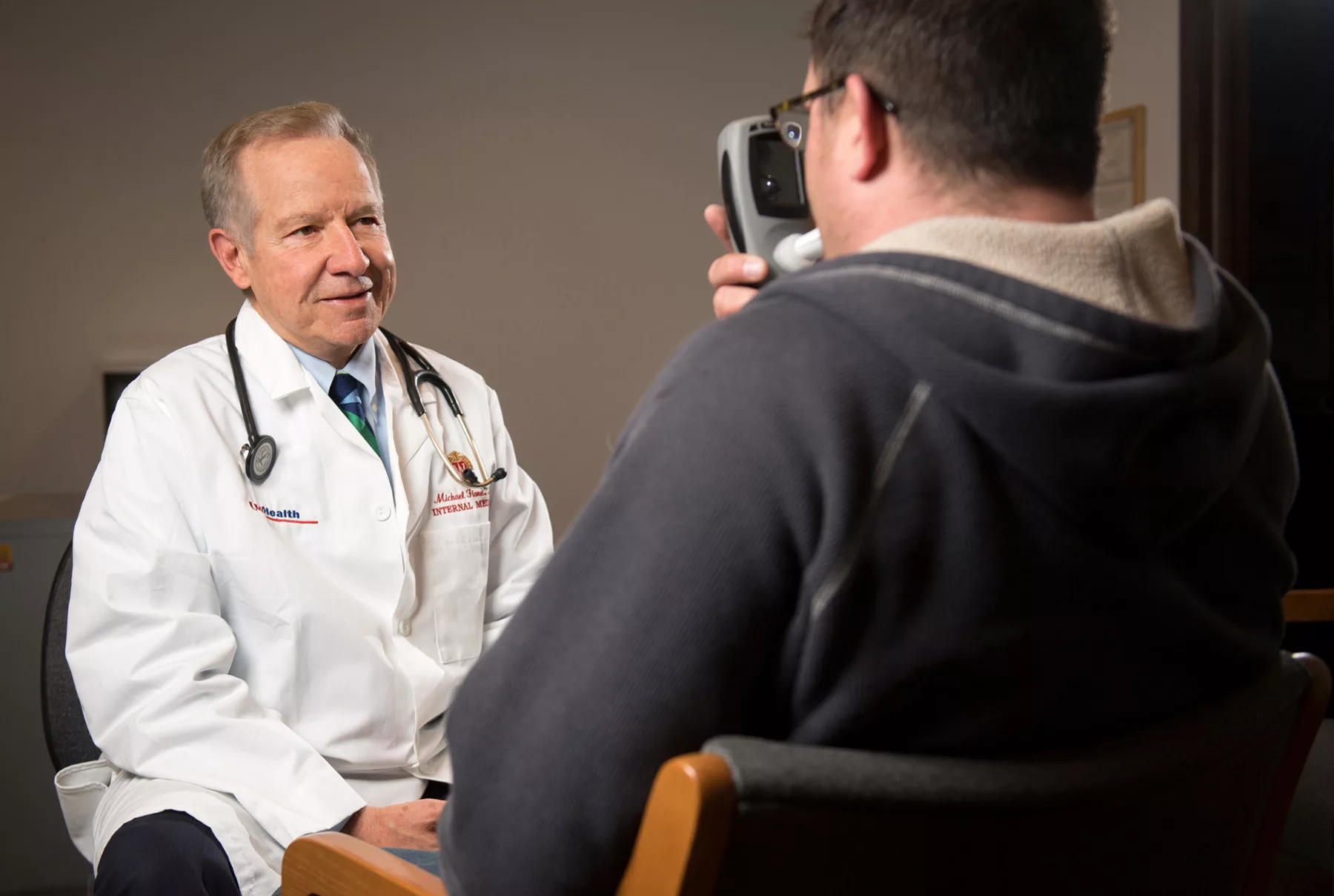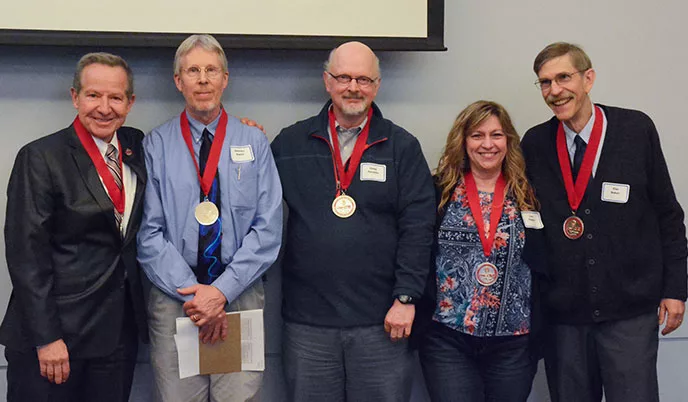
Mike Eheler didn’t want to die and leave his wife and four kids without him. Like most smokers, he became addicted as a kid. He had smoked for 23 years, his grandmother had died from lung cancer, and now he could feel the toll on his health — and on his ability to support his family in the way he’d dreamed. It was slipping away, one $7 pack of carcinogens at a time.
But Eheler couldn’t quit, despite his best efforts. Then he saw an advertisement for the Wisconsin Smokers’ Health Study at the University of Wisconsin Center for Tobacco Research and Intervention (UW-CTRI).
“It helped,” Eheler says, with relief. “It had to do with me really wanting to quit and the medication I was given.”
He also credits Chris Ripley, a health counselor with UW-CTRI, for supporting him. “Without that help, I don’t think I would have been able to quit,” he says.
Eheler is now healthy enough to play ball with his kids. With the money he would have spent on cigarettes, he has taken his family to Disney World and used some of it toward buying a house.
“I feel like I got a lot more years added to my life to spend with my kids,” shares Eheler.
Michael Fiore, MD, MPH, MBA, UW-CTRI founder and director, notes, “We’re all about helping people. Through our research, we’re searching for clues to arrest tobacco addiction and put away — for good — the disease and death it causes.”
He continues, “During our 25-year history, UW-CTRI has been able to help many patients like Mike Eheler. More than 250,000 Wisconsin smokers have benefited from the Wisconsin Tobacco Quit Line and other cessation programs. And our partnership with the UW Carbone Cancer Center expands our capacity to prevent deadly tobacco-caused cancers.”
Searching for Clues Through Research
Tobacco products are the leading preventable cause of death in the United States, killing approximately 500,000 people per year — more than deaths by homicide, suicide, illegal drugs and motor vehicle accidents combined. Even smokers who survive often suffer from debilitating ailments like poor lung capacity, heart trouble, missing teeth or amputated limbs. Counseling and medications can help patients like Eheler quit, but solving addiction for all smokers remains a mystery.

While UW-CTRI investigators don’t use a Sherlock Holmes-style magnifying glass, they use techniques like genotyping and carbon monoxide monitoring to search for clues to better help people quit using tobacco.
Under the leadership of Fiore and Timothy Baker, PhD, UW-CTRI director of research, the center’s team of scientists and staff has authored more than 300 research articles on tobacco addiction and treatment.
For instance, UW-CTRI researchers have published key articles that show the effectiveness of the major medication treatments for smoking; the helpfulness of quit-line counseling and how to get smokers to use it; and ways to engage health care systems in treating tobacco use.
Recently, studies by Dave Fraser, UW-CTRI director of research administration, and colleagues from the Wisconsin Department of Health Services showed that financial incentives can powerfully motivate low-income smokers to engage in treatment and actually quit smoking. In addition, UW-CTRI scientists — including Megan Piper, PhD ’06, Danielle McCarthy, PhD ’06, Jessica Cook, PhD, and Tanya Schlam, PhD — have developed new treatments for smoking, using powerful new research methods.
The late U.S. Surgeon General C. Everett Koop, MD, once said quitting smoking was at least as difficult as quitting cocaine or heroin; subsequent research backed that assertion. UW-CTRI researchers have committed to answering the question, “What makes the hold of tobacco use so tenacious?”
“We know the same systems in the brain that are activated by nicotine are activated when an infant sees its mother,” explains Baker. “It is clear that nicotine has the potential to turn on very basic and powerful brain-reward and motivational systems.”
UW-CTRI investigators also have discovered that flavors seem related to tobacco use. For instance, Stevens Smith, PhD, and his colleagues have shown that smoking menthol cigarettes appears to reduce the likelihood of quitting smoking. And recently, Piper, the UW-CTRI associate director for research, and Doug Jorenby, PhD, its director of clinical services, have examined motives for smoking and vaping. These studies should help researchers better understand how addictive e-cigarettes can be, whether smokers are using them to quit, and the health effects of the devices.
All-Points Bulletin to Health Care Providers
In 2008, the U.S. Public Health Service released its updated Clinical Practice Guideline, Treating Tobacco Use and Dependence, which was assembled by a large team of scientists from throughout the nation, led by UW-CTRI and chaired by Fiore. Like an “APB” to law enforcement officials, the guideline signals to clinicians that they need to be “on the look-out” for their patients’ tobacco use and:
- Ask about tobacco use at every visit
- Advise those who use tobacco to quit assess the patient’s readiness to quit (research shows 70 percent want to quit)
- Assist with quitting by providing medication and counseling — in-person or via referral to the Quit Line
- Arrange for follow-up
The former director of the U.S. Centers for Disease Control and Prevention (CDC), Tom Frieden, MD, MPH, heralded the guideline, saying, “What you have here is the best of the best in the release of a clinical practice guideline. In the process, content, practicality and the rigor of its work, I really salute all the people who worked on it, for what really should be a model for any clinic or medical practice.”
In the early 1990s, UW-CTRI researchers were the first to propose making tobacco use a vital sign — something doctors would assess at every visit, just like a patient’s blood pressure. When doctors intervene, smokers are twice as likely to quit. Back then, only one of five patients was asked by their doctors if they smoked. Now, nearly every patient is asked that question.
“This sort of systematic change in health care delivery is our goal,” says Rob Adsit, MEd, UW-CTRI outreach director.
UW-CTRI’s outreach team strives to embody the Wisconsin Idea by taking the latest research about how to help patients quit and sharing it with doctors, nurses, psychologists, pharmacists, dentists and other providers from all disciplines. They’ve worked with more than 22,000 professionals representing every health care system in Wisconsin. The team helps systems incorporate the latest research into their
standard of care.
Because clinicians are so busy, one of UW-CTRI’s aims has been to help doctors refer smokers to the Quit Line at 800‑QUIT‑NOW. It’s a win-win: patients get free, state-of-the-art treatments to quit smoking, while doctors can help more patients eliminate smoking from their lives.
Leveraging Technology
UW-CTRI has worked with Epic Systems Corporation — the Dane County-based worldwide leader in electronic health records (EHR) technology — to design and test a system that allows clinicians to electronically refer patients who use tobacco products to the Quit Line. The system provides service outcomes to clinicians in a secure, “closed‑loop” manner.
Several health care systems, including 37 UW Health clinics, have implemented the EHR-based referral program.
Putting Tobacco Away for Good
Fiore recently penned a commentary in the New England Journal of Medicine that included a blueprint for ending tobacco use in the United States. He outlined these strategies to put the proverbial handcuffs on this leading killer:
- Implement the U.S. Food and Drug Administration’s full authority for tobacco product regulation
- Mandate the inclusion of graphic warning labels on all tobacco products
- Provide barrier-free access to proven tobacco treatments
- Raise state and federal cigarette excise taxes, with the rationale that the more tobacco costs, the less people use it
- Prohibit the sale of any tobacco product to people younger than 21
- Sustain successful national media campaigns
- Focus on helping populations with the highest smoking prevalence
- Enforce the Housing and Urban Development smoke-free housing rule
- Expand tobacco research
- Fully fund comprehensive, statewide tobacco-control programs at CDC-recommended levels
- Extend comprehensive, smoke-free indoor-air protections to all Americans

While the percentage of people who smoke in the United States has dropped from nearly half the population after World War II to about 15 percent today — a dramatic public health accomplishment — smoking rates remain much higher among vulnerable groups. Those with mental illness or substance-abuse issues smoke nearly half the cigarettes in the nation. Evidence shows that tobacco companies target minorities.
UW-CTRI collaborates with the Wisconsin Department of Health Services and nonprofit organizations like the Salvation Army to help people across the state to quit smoking, including those who are poor and homeless, have behavioral health issues or are marginalized in other ways. Bruce Christiansen, PhD, a UW-CTRI researcher, leads many of these efforts. “
We’ve made progress,” he reflects, “but there’s much work left to be done.”
And Eheler exclaims, “I have to thank the Smokers’ Study. I have no ambition to smoke, thank you very much!”